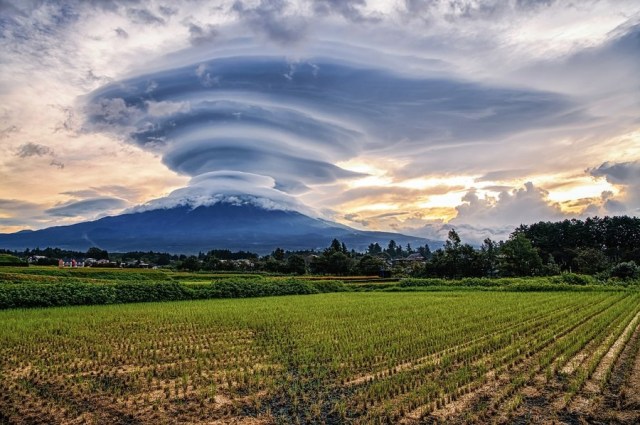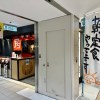
It’s aliens, right?
There’s no mountain in Japan that more people want to see than Mt. Fuji, but unfortunately it’s one of the hardest mountains to catch a glimpse of. Local geography and weather patterns mean that even though Fuji is the highest peak in the country, it’s often shrouded in mist and obscured by clouds, much to the dismay of travelers and photographers.
And sure enough, when Japanese Twitter user Taitan (@taitan21) pointed his camera towards Mt. Fuji the other day, there was a big old cloud between where he was standing in Fuji City, Shizuoka Prefecture, and the mountain. For once, though, that didn’t ruin the shot, but only made it all the more incredible.
おはようございます。雨上がりの朝、富士山に巨大吊るし雲が見られました! pic.twitter.com/8Y0QD40FJJ
— Taitan (@taitan21) September 17, 2020
With Mt. Fuji being a symbol of the country, the average Japanese person sees countless photos of the mountain, but few had ever seen it looking like this, prompting many to give their tongue-in-cheek theories as to what’s going on in the photo.
“So that’s a spaceship, right?”
“I think Mt. Fuji might be erupting.”
“Without question, if you travel to the center of that cloud you’ll find [Studio Ghibli’s Castle in the Sky] Laputa.”
“Waiting for Fujin and Raijin [Shinto gods of wind and lightning] to appear.”
“Are the gods making cotton candy?”
There’s an explanation that doesn’t involve extraterrestrials or deities, though. This type of cloud formation is called a lenticular cloud, but in this case the Japanese term, tsurushigumo, or “hanging cloud,” might be easier to mentally grasp.
今日18日(金)は富士山周辺に大きなつるし雲が現れています。前線の南下により、上空3000m付近では30m/s近い南西の風が吹いているためです。https://t.co/QslQAz06Ny pic.twitter.com/EltbUuta5Z
— ウェザーニュース (@wni_jp) September 17, 2020
In simple terms, these kind of clouds form when moist air is blown by the wind over the top of a high mountain. As it move to the far side of the mountain, the wind forms a wave-like current, and the air cools. If it gets cool enough, a cloud forms between where the wind wave rises and falls, and the reduced lateral current keeps it in place, forming an increasingly large cloud with a lens-like shape that “hangs” in the same spot of the sky.
▼ A view of the cloud from Yamanashi Prefecture, on the opposite side of Mt. Fuji from where Taitan took his photo.
外から失礼しますm(__)m
— 𝐬𝐣 (@__sj1024) September 18, 2020
山梨県側の写真です🗻 pic.twitter.com/smbAqUfFgu
With rain the previous day and cool overnight temperatures, the conditions were just right at the time Taitan’s photo was taken. Of course, being a resident of Fuji City, he has plenty of chances to take picture of the mountain, and the “hanging cloud” shot is far from his only breathtaking photo.
おはようございます。里山の田園からの朝焼け雲と富士山の風景です! pic.twitter.com/uZsJ2Gp0K8
— Taitan (@taitan21) September 23, 2020
「ブログ@お天気屋さん」新着記事: 雁堤と岩本山公園の彼岸花 2020 https://t.co/2b2feY3tj9 pic.twitter.com/4e17P0vvSP
— Taitan (@taitan21) September 23, 2020
The common wisdom is that winter, the driest season in Japan, is the best time to photograph Mt. Fuji. But as Taitan’s works show, it has a unique beauty on cloudy days too, so there’s no need to postpone your visit until the coldest part of the year.
Sources: Twitter/@taitan21 via IT Media, Weather News
Top image: Twitter/@taitan21
● Want to hear about SoraNews24’s latest articles as soon as they’re published? Follow us on Facebook and Twitter!

 Mt. Fuji becomes Studio Ghibli’s Laputa following recent typhoon 【Photos】
Mt. Fuji becomes Studio Ghibli’s Laputa following recent typhoon 【Photos】 Nude photos of Mt. Fuji circulate online as powerful typhoon removes snow from the peak【Photos】
Nude photos of Mt. Fuji circulate online as powerful typhoon removes snow from the peak【Photos】 Mt. Fuji gets covered with beautiful umbrella cloud that also has some people seeing a fried egg
Mt. Fuji gets covered with beautiful umbrella cloud that also has some people seeing a fried egg Mt. Fuji jelly makes Japan’s most famous mountain a delight to look at and taste!
Mt. Fuji jelly makes Japan’s most famous mountain a delight to look at and taste! Free Wi-Fi is coming to Mt. Fuji this summer
Free Wi-Fi is coming to Mt. Fuji this summer How to order snacks on a Shinkansen bullet train in Japan
How to order snacks on a Shinkansen bullet train in Japan Demon Slayer: Kimetsu no Yaiba gets new roller coaster attractions and food at Universal Studios Japan
Demon Slayer: Kimetsu no Yaiba gets new roller coaster attractions and food at Universal Studios Japan Nintendo history you can feel – Super NES, N64, and GameCube controllers become capsule toys
Nintendo history you can feel – Super NES, N64, and GameCube controllers become capsule toys New Nintendo Lego kit is a beautiful piece of moving pixel art of Mario and Yoshi【Photos】
New Nintendo Lego kit is a beautiful piece of moving pixel art of Mario and Yoshi【Photos】 Japan’s new difficult-to-drink-from beer glass protects your liver, but it’s a brutal experience
Japan’s new difficult-to-drink-from beer glass protects your liver, but it’s a brutal experience A visit to the best UFO catcher arcade in the universe!
A visit to the best UFO catcher arcade in the universe! To combat declining birth rate, Japan to begin offering “Breeding Visas” to foreigners
To combat declining birth rate, Japan to begin offering “Breeding Visas” to foreigners Tokyo Station’s perfect breakfast spot might just be this izakaya Japanese-style pub
Tokyo Station’s perfect breakfast spot might just be this izakaya Japanese-style pub Sex doll sharing service shut down by Chinese authorities
Sex doll sharing service shut down by Chinese authorities High-fashion Totoro cuddle purse is like an elegant stroll in the forest【Photos】
High-fashion Totoro cuddle purse is like an elegant stroll in the forest【Photos】 Hello, cosmetics! Clinique teams up with Hello Kitty this summer for first-time collaboration
Hello, cosmetics! Clinique teams up with Hello Kitty this summer for first-time collaboration “The most Delicious Cup Noodle in history” – Japan’s French Cup Noodle wins our heart【Taste test】
“The most Delicious Cup Noodle in history” – Japan’s French Cup Noodle wins our heart【Taste test】 Starbucks releases a cute Frappuccino and Unicorn Cake…but not in Japan
Starbucks releases a cute Frappuccino and Unicorn Cake…but not in Japan Kyoto Tower mascot termination reveals dark side behind cute Japanese characters
Kyoto Tower mascot termination reveals dark side behind cute Japanese characters McDonald’s Japan’s Soft Twist Tower: A phantom ice cream only sold at select branches
McDonald’s Japan’s Soft Twist Tower: A phantom ice cream only sold at select branches Yabai Ramen: What makes this Japanese ramen so dangerous?
Yabai Ramen: What makes this Japanese ramen so dangerous? Finally! Nintendo Japan expands Switch 8-bit controller sales to everybody, Online member or not
Finally! Nintendo Japan expands Switch 8-bit controller sales to everybody, Online member or not Japanese government wants to build luxury resorts in all national parks for foreign tourists
Japanese government wants to build luxury resorts in all national parks for foreign tourists 10 things you should buy at 7-Eleven in Japan
10 things you should buy at 7-Eleven in Japan Studio Ghibli releases anime heroine cosplay dresses that are super comfy to wear
Studio Ghibli releases anime heroine cosplay dresses that are super comfy to wear Woman charged for driving suitcase without a license in Osaka
Woman charged for driving suitcase without a license in Osaka Studio Ghibli unveils My Neighbour Totoro miniature house model
Studio Ghibli unveils My Neighbour Totoro miniature house model Kyoto experiencing problems with foreign tourists not paying for bus fares, but not on purpose
Kyoto experiencing problems with foreign tourists not paying for bus fares, but not on purpose Fighting mild hunger with a Japanese soda that turns into jelly in the stomach【Taste test】
Fighting mild hunger with a Japanese soda that turns into jelly in the stomach【Taste test】 Studio Ghibli’s Howl’s Moving Castle tapestry unveiled in Japan for first time
Studio Ghibli’s Howl’s Moving Castle tapestry unveiled in Japan for first time McDonald’s new Happy Meals offer up cute and practical Sanrio lifestyle goods
McDonald’s new Happy Meals offer up cute and practical Sanrio lifestyle goods Sales of Japan’s most convenient train ticket/shopping payment cards suspended indefinitely
Sales of Japan’s most convenient train ticket/shopping payment cards suspended indefinitely Sold-out Studio Ghibli desktop humidifiers are back so Totoro can help you through the dry season
Sold-out Studio Ghibli desktop humidifiers are back so Totoro can help you through the dry season Japanese government to make first change to romanization spelling rules since the 1950s
Japanese government to make first change to romanization spelling rules since the 1950s Foreigner’s request for help in Tokyo makes us sad for the state of society
Foreigner’s request for help in Tokyo makes us sad for the state of society Ghibli founders Toshio Suzuki and Hayao Miyazaki contribute to Japanese whisky Totoro label design
Ghibli founders Toshio Suzuki and Hayao Miyazaki contribute to Japanese whisky Totoro label design Doraemon found buried at sea as scene from 1993 anime becomes real life【Photos】
Doraemon found buried at sea as scene from 1993 anime becomes real life【Photos】 Tokyo’s most famous Starbucks is closed
Tokyo’s most famous Starbucks is closed Princesses, fruits, and blacksmiths: Study reveals the 30 most unusual family names in Japan
Princesses, fruits, and blacksmiths: Study reveals the 30 most unusual family names in Japan Photos of “everyday life” in the town next to Mt. Fuji look like a beautiful fantasy world
Photos of “everyday life” in the town next to Mt. Fuji look like a beautiful fantasy world Fuji Dream Airlines is offering limited Mt. Fuji sightseeing flights
Fuji Dream Airlines is offering limited Mt. Fuji sightseeing flights Barricades placed on Mt. Fuji as mountain officially closes because of coronavirus【Video】
Barricades placed on Mt. Fuji as mountain officially closes because of coronavirus【Video】 Photographs of mysterious globe cloud in Japan causing quite a storm online
Photographs of mysterious globe cloud in Japan causing quite a storm online Beautiful mountain farmlands are yet another reason to visit rural Japan
Beautiful mountain farmlands are yet another reason to visit rural Japan Laser-cut, 360-degree “book” lets you bring Mt. Fuji into your home
Laser-cut, 360-degree “book” lets you bring Mt. Fuji into your home Amazing photos show Mt. Fuji looking just like an ukiyo-e woodblock painting
Amazing photos show Mt. Fuji looking just like an ukiyo-e woodblock painting Turn a glass of beer into an exquisite Mt. Fuji scene with this Awakumo glass!
Turn a glass of beer into an exquisite Mt. Fuji scene with this Awakumo glass! Hike from the sea to the peak of Mt. Fuji with new bilingual English/Japanese guide map series
Hike from the sea to the peak of Mt. Fuji with new bilingual English/Japanese guide map series “Floating” Mt Fuji and shrine gates capture the hidden beauty of Japan【Photos】
“Floating” Mt Fuji and shrine gates capture the hidden beauty of Japan【Photos】 Mt Fuji and Raijin and Fujin lingerie sets let you wear your love for Japan under your clothes
Mt Fuji and Raijin and Fujin lingerie sets let you wear your love for Japan under your clothes Mt. Fuji is officially closed for the year
Mt. Fuji is officially closed for the year Pre-dawn photo of Mt. Fuji looks almost too beautiful to be real
Pre-dawn photo of Mt. Fuji looks almost too beautiful to be real Search for live-streamer who fell from Mt. Fuji finds badly damaged corpse half-mile below peak
Search for live-streamer who fell from Mt. Fuji finds badly damaged corpse half-mile below peak Hiking restrictions result in huge drop in climbing accidents, with zero on Mt. Fuji
Hiking restrictions result in huge drop in climbing accidents, with zero on Mt. Fuji
Leave a Reply